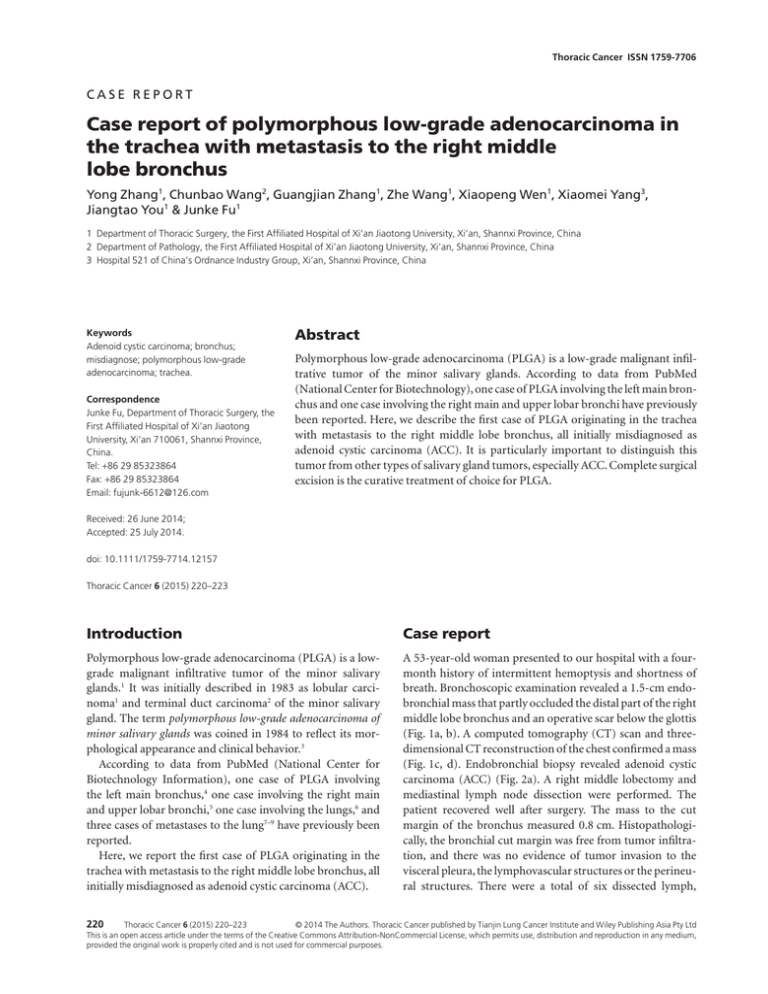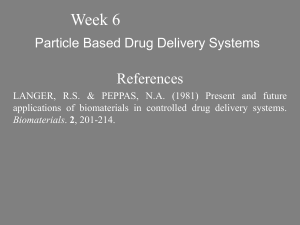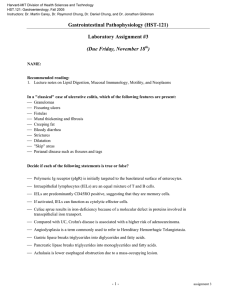- Wiley Online Library
advertisement

Thoracic Cancer ISSN 1759-7706 CASE REPORT Case report of polymorphous low-grade adenocarcinoma in the trachea with metastasis to the right middle lobe bronchus Yong Zhang1, Chunbao Wang2, Guangjian Zhang1, Zhe Wang1, Xiaopeng Wen1, Xiaomei Yang3, Jiangtao You1 & Junke Fu1 1 Department of Thoracic Surgery, the First Affiliated Hospital of Xi’an Jiaotong University, Xi’an, Shannxi Province, China 2 Department of Pathology, the First Affiliated Hospital of Xi’an Jiaotong University, Xi’an, Shannxi Province, China 3 Hospital 521 of China’s Ordnance Industry Group, Xi’an, Shannxi Province, China Keywords Adenoid cystic carcinoma; bronchus; misdiagnose; polymorphous low-grade adenocarcinoma; trachea. Correspondence Junke Fu, Department of Thoracic Surgery, the First Affiliated Hospital of Xi’an Jiaotong University, Xi’an 710061, Shannxi Province, China. Tel: +86 29 85323864 Fax: +86 29 85323864 Email: fujunk-6612@126.com Abstract Polymorphous low-grade adenocarcinoma (PLGA) is a low-grade malignant infiltrative tumor of the minor salivary glands. According to data from PubMed (National Center for Biotechnology), one case of PLGA involving the left main bronchus and one case involving the right main and upper lobar bronchi have previously been reported. Here, we describe the first case of PLGA originating in the trachea with metastasis to the right middle lobe bronchus, all initially misdiagnosed as adenoid cystic carcinoma (ACC). It is particularly important to distinguish this tumor from other types of salivary gland tumors, especially ACC. Complete surgical excision is the curative treatment of choice for PLGA. Received: 26 June 2014; Accepted: 25 July 2014. doi: 10.1111/1759-7714.12157 Thoracic Cancer 6 (2015) 220–223 Introduction Case report Polymorphous low-grade adenocarcinoma (PLGA) is a lowgrade malignant infiltrative tumor of the minor salivary glands.1 It was initially described in 1983 as lobular carcinoma1 and terminal duct carcinoma2 of the minor salivary gland. The term polymorphous low-grade adenocarcinoma of minor salivary glands was coined in 1984 to reflect its morphological appearance and clinical behavior.3 According to data from PubMed (National Center for Biotechnology Information), one case of PLGA involving the left main bronchus,4 one case involving the right main and upper lobar bronchi,5 one case involving the lungs,6 and three cases of metastases to the lung7–9 have previously been reported. Here, we report the first case of PLGA originating in the trachea with metastasis to the right middle lobe bronchus, all initially misdiagnosed as adenoid cystic carcinoma (ACC). A 53-year-old woman presented to our hospital with a fourmonth history of intermittent hemoptysis and shortness of breath. Bronchoscopic examination revealed a 1.5-cm endobronchial mass that partly occluded the distal part of the right middle lobe bronchus and an operative scar below the glottis (Fig. 1a, b). A computed tomography (CT) scan and threedimensional CT reconstruction of the chest confirmed a mass (Fig. 1c, d). Endobronchial biopsy revealed adenoid cystic carcinoma (ACC) (Fig. 2a). A right middle lobectomy and mediastinal lymph node dissection were performed. The patient recovered well after surgery. The mass to the cut margin of the bronchus measured 0.8 cm. Histopathologically, the bronchial cut margin was free from tumor infiltration, and there was no evidence of tumor invasion to the visceral pleura, the lymphovascular structures or the perineural structures. There were a total of six dissected lymph, 220 Thoracic Cancer 6 (2015) 220–223 © 2014 The Authors. Thoracic Cancer published by Tianjin Lung Cancer Institute and Wiley Publishing Asia Pty Ltd This is an open access article under the terms of the Creative Commons Attribution-NonCommercial License, which permits use, distribution and reproduction in any medium, provided the original work is properly cited and is not used for commercial purposes. Y. Zhang et al. Polymorphous low-grade adenocarcinoma Figure 1 (a) Bronchoscopic examination revealed an operative scar below the glottis (abnormal healing after the tracheal tumorectomy). (b/d) Bronchoscopic examination and three-dimensional computed tomography reconstruction demonstrated a mass in the distal part of the right middle lobe bronchus. (c) A computed tomography CT scan showed atelectasis of the right middle lobe. (e-g) Positron emission tomography (PET)-CT scans (2010, 2012, 2013) demonstrated two masses in the medial segment of the right middle lobe. Figure 2 (a) Endobronchial biopsy of the right middle lobe bronchus. (b–f) Histopathological examination after right middle lobectomy. (b–e) The organizational structure of the tumor cells is diversiform, including solid, complex adenoid, papillary, and sieve-like structure. (f) The transitional region, from the cell enrichment region to the structurally diverse region. (g) Endotracheal biopsy. (h–j) Histopathological examination after tracheal tumorectomy. Thoracic Cancer 6 (2015) 220–223 © 2014 The Authors. Thoracic Cancer published by Tianjin Lung Cancer Institute and Wiley Publishing Asia Pty Ltd 221 Polymorphous low-grade adenocarcinoma Y. Zhang et al. tracheobronchial, and subcarinal nodes, and all were negative for tumor invasion. Postoperative pathology also revealed ACC (Fig. 2b). Positron emission tomography (PET)-CT scans, which were regularly performed and reviewed (2010, 2012, 2013), demonstrated two masses in the medial segment of the right middle lobe (Fig. 1e–g) with no abnormity at other sites. Bronchoscopic examination revealed an operative scar below the glottis as a result of treatment performed 10 years earlier. The patient had been hospitalized with a one-year history of shortness of breath and a two-month history of blood in the sputum. A CT scan demonstrated a 1.7 cm cauliflower-like soft-tissue mass in the trachea at the level of the thyroid gland. An endotracheal biopsy revealed ACC (Fig. 2g). A tracheal tumorectomy with end-to-end anastomosis was performed. The patient recovered uneventfully after surgery. In terms of gross appearance, the mass was found to be 3 cm in diameter with a pedicel of approximately 2 cm × 1 cm. The microscopic finding revealed that the mass had invaded through the full thickness of the trachea wall. Histopathological examination after the operation also revealed ACC (Fig. 2h–j). To determine whether the tumor of the right middle lobe bronchus was homologous with that of the trachea, hematoxylin and eosin staining of the bronchoscopic and postoperative specimens of the trachea and the right middle lobe bronchus were retrospectively analyzed, and immunohistochemical examination of all specimens were performed. The results revealed that the organizational structure of the tumor cells was diversiform, including solid, complex adenoid, papillary, and sieve-like structures. The nuclei of the tumor cells were round and uniform (Fig. 2c). Immunohistochemically, the tumor cells were all positive for cytokeratin (CK), CK8, periodic acid schiff, and alcian blue, and all negative for carcinoembryonic antigen, GCDF15, S-100, actin, smooth muscle actin, P63, NapsinA, and thyroid transcription factor-1. PET-CT was performed as blood in the sputum was again found four years ago. The blood in the sputum disappeared after another period of radiotherapy (60 CG). The final diagnosis was tracheal PLGA, therefore, the patient underwent periodic review. Primary tracheal tumors have various histological features. They can arise from the respiratory epithelia, salivary glands, and mesenchymal structures of the trachea.10 Tracheal tumors arising from salivary glands include pleomorphic adenoma, mucoepidermoid carcinoma, ACC and PLGA. Pleomorphic adenoma is benign, whereas mucoepidermoid carcinoma and ACC are malignant tumors and demonstrate more aggressive behavior compared to PLGA. Thoracic Cancer 6 (2015) 220–223 Conclusion This is the first reported case of PLGA originating in the trachea. Complete surgical resection is the treatment of choice. Whether adjuvant radiotherapy could be beneficial for treatment requires further study. Disclosure No authors report any conflict of interest. References Discussion 222 The tumor is locally invasive, with a low predilection for recurrence or lymph node metastases. The organizational structure of PLGA cells is diversiform, as demonstrated in this case. The nuclei of PLGA cells are slightly larger, rounder, and more uniform compared with those of ACC. The cytoplasm of PLGA cells is more eosinophilic than that of ACC. Complete surgical excision is the curative treatment of choice for PLGA.10,11 A large study of 164 cases12 showed that 97.6% of all patients were alive or had died of unrelated disease after a mean follow-up of 115.4 months following treatment with surgical excision only. The characteristics of this case are as follows: 1 Regions of sieve-like structured cell enrichment (Fig. 2a, b, g–j), such as those found in ACC, mislead pathologists. The transitional region, from the cell enrichment region to the structurally diverse region (Fig. 2f), and the uniform nuclei confirm a diagnosis of PLGA (Fig. 2b–f). Immunohistochemical staining indicates that the tumors are homologous. 2 The final pathological diagnosis was tracheal PLGA and metastasis to the right middle lobe bronchus. 3 No PLGA in the trachea has been reported previously; this is the first reported case of PLGA originating in the trachea. 4 Castle et al.12 argued that tumors localized to the hard palate were statistically significantly more likely to be associated with tumor recurrence/persistence or patient death, but not those in other anatomic locations. It is not well known whether PLGA in the tracheobronchus is recurrent or metastasizes. 1 Freedman PD, Lumerman H. Lobular carcinoma of intraoral minor salivary gland origin. Report of twelve cases. Oral Surg Oral Med Oral Pathol 1983; 56: 157–66. 2 Batsakis JG, Pinkston GR, Luna MA, Byers RM, Sciubba JJ, Tillery GW. Adenocarcinomas of the oral cavity: a clinicopathologic study of terminal duct carcinomas. J Laryngol Otol 1983; 97: 825–35. 3 Evans HL, Batsakis JG. Polymorphous low-grade adenocarcinoma of minor salivary glands. A study of 14 cases of a distinctive neoplasm. Cancer 1984; 53: 935–42. © 2014 The Authors. Thoracic Cancer published by Tianjin Lung Cancer Institute and Wiley Publishing Asia Pty Ltd Y. Zhang et al. Polymorphous low-grade adenocarcinoma 4 Boonsarngsuk V, Suwatanapongched T, Rochanawutanon M, Ngodngamthaweesuk M, Prakardvudhisarn P. Primary polymorphous low-grade adenocarcinoma of the bronchus: complete tumor removal with bronchoscopic resection. Lung Cancer 2009; 63: 301–4. 5 Cho KD, Jung JH, Cho DG et al. Primary polymorphous low-grade adenocarcinoma of lung treated by sleeve bronchial resection: a case report. J Korean Med Sci 2007; 22: 373–6. 6 Lee VK, McCaughan BC, Scolyer RA. Polymorphous low-grade adenocarcinoma in the lung: a case report. Int J Surg Pathol 2004; 12: 287–92. 7 Tanaka F, Wada H, Inui K et al. Pulmonary metastasis of polymorphous low-grade adenocarcinoma of the minor salivary gland. Thorac Cardiovasc Surg 1995; 43: 178–80. Thoracic Cancer 6 (2015) 220–223 8 Hannen EJ, Bulten J, Festen J, Wienk SM, de Wilde PC. Polymorphous low grade adenocarcinoma with distant metastases and deletions on chromosome 6q23-qter and 11q23-qter: a case report. J Clin Pathol 2000; 53: 942–5. 9 Monaco SE, Khalbuss WE, Ustinova E, Liang A, Cai G. The cytomorphologic spectrum of salivary gland type tumors in the lung and mediastinum: a report of 16 patients. Diagn Cytopathol 2012; 40: 1062–70. 10 Macchiarini P. Primary tracheal tumours. Lancet Oncol 2006; 7: 83–91. 11 Gaissert HA, Mark EJ. Tracheobronchial gland tumors. Cancer Control 2006; 13: 286–94. 12 Castle JT, Thompson LD, Frommelt RA, Wenig BM, Kessler HP. Polymorphous low grade adenocarcinoma: a clinicopathologic study of 164 cases. Cancer 1999; 86: 207–19. © 2014 The Authors. Thoracic Cancer published by Tianjin Lung Cancer Institute and Wiley Publishing Asia Pty Ltd 223


